The United States operates the most technologically advanced fighter fleet in the world, with capabilities spanning air superiority, ground attack, and multirole missions. U.S. fighters have seen continuous combat since World War II.
History of U.S. Military Aviation
The United States' journey as a global air power began in 1909 when the War Department purchased its first military aircraft from the Wright brothers. Initially used for reconnaissance, aircraft quickly became weaponized during World War I. The 94th Aero Squadron's "Hat-in-the-Ring" fighters engaged in dogfights over Europe, introducing America to aerial combat.
The interwar years saw crucial technological leaps. Billy Mitchell's controversial advocacy for air power proved prescient as Boeing developed the B-17 Flying Fortress. The 1930s brought all-metal monoplanes like the P-26 Peashooter, while the Navy perfected carrier operations with planes like the Grumman F3F.
World War II transformed American aviation. Over 300,000 aircraft were produced, including iconic fighters like the P-51 Mustang that achieved air superiority over Europe. The Pacific theater showcased carrier-based dominance with F6F Hellcats defeating Japanese Zeros. This era also saw the revolutionary B-29 Superfortress and the atomic missions that ended the war.
The Cold War propelled jet aviation. The F-86 Sabre's victory over MiG-15s in Korea demonstrated jet fighter supremacy. The 1960s introduced supersonic fighters like the F-4 Phantom II, though Vietnam exposed limitations in missile-only armament, reviving emphasis on dogfighting skills.
Modern U.S. air dominance took shape in the 1970s-80s with fourth-generation fighters. The F-15 Eagle's "not a pound for air-to-ground" philosophy produced an undefeated air superiority record, while the F-16's fly-by-wire system redefined agile light fighters. Stealth technology emerged with Lockheed's F-117 Nighthawk, proving its worth in 1991's Desert Storm.
The 21st century introduced fifth-generation fighters. The F-22 Raptor combined supercruise, stealth, and sensor fusion for unmatched air dominance. The F-35 Lightning II program created a tri-variant stealth fighter family, though not without controversy over costs and complexity. Meanwhile, unmanned systems like the MQ-9 Reaper transformed reconnaissance and strike missions.
Today's USAF and Naval Aviation maintain qualitative superiority through continuous upgrades like the F-15EX and F-16V, while developing sixth-generation NGAD (Next Generation Air Dominance) fighters. From fabric biplanes to AI-assisted stealth jets, America's military aviation history reflects relentless innovation, shaping global air combat doctrine for over a century.
 An F-86 Sabre during a Heritage Flight over Davis-Monthan
AFB
An F-86 Sabre during a Heritage Flight over Davis-Monthan
AFB
 F-14 of Fighter Squadron One Five Four (VF-154) flies away
from Naval Air Facility Atsugi, Japan, for the last time.
(Sept. 24, 2003)
F-14 of Fighter Squadron One Five Four (VF-154) flies away
from Naval Air Facility Atsugi, Japan, for the last time.
(Sept. 24, 2003)
Active U.S. Fighter Aircraft
| Aircraft | Role | Introduced | Quantity |
|---|---|---|---|
| F-15E Strike Eagle | Multirole Strike Fighter | 1989 | 218 |
| F-15EX Eagle II | Multirole Fighter | 2021 | 8 (104 planned) |
| F-16C Fighting Falcon | Multirole Fighter | 1984 | 708 |
| F-22A Raptor | 5th Gen Air Superiority | 2005 | 178 |
| F-35A Lightning II | 5th Gen Multirole | 2016 | 385 |
| F/A-18E/F Super Hornet | Carrier-Based Multirole | 1999 | 500+ |
| F-35B Lightning II | STOVL Multirole | 2015 | 300+ |
| F-35C Lightning II | Carrier-Based Multirole | 2019 | 100+ |